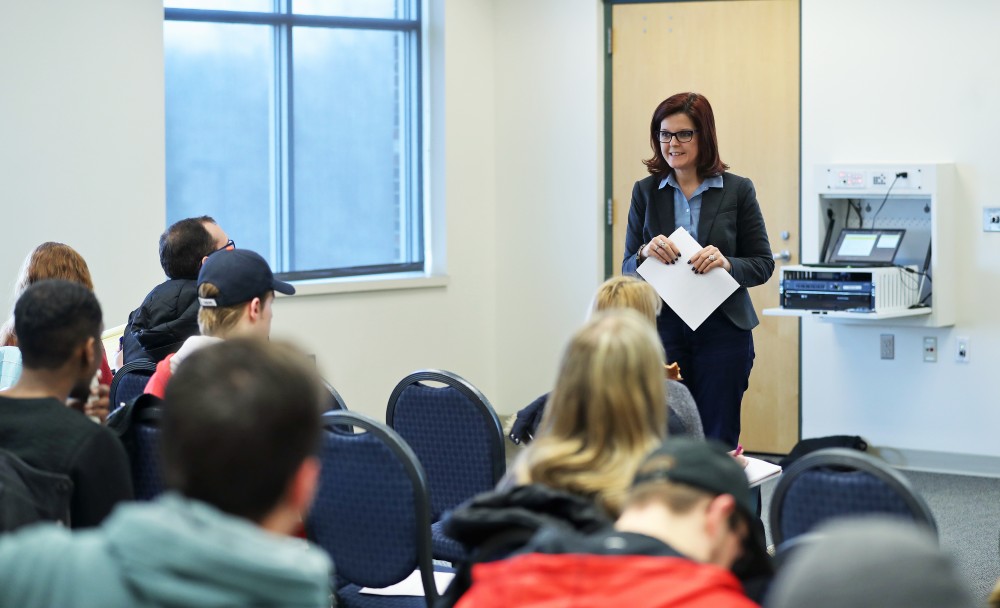Do third parties stand a chance?

GVL/Kevin Sielaff – Heather Tafel, associate professor of political science at GVSU, presents during Grand Valley’s first Democracy: 101 event inside the Kirkhof Center on Wednesday, Feb. 15, 2017.
Feb 16, 2017
The 2016 presidential election sparked fresh debate about the role and potential of third parties in the United States’ political system. Is it worthwhile to vote for a third-party candidate, or would that be throwing away a vote? Is there any chance for a third party to receive enough support to break the long-standing two-party system?
To answer these and other questions, the Grand Valley State University Community Service Learning Center (CSLC) hosted its first Democracy 101 event, “Elections & Two-Party Systems: Why Third Parties Have It Rough,” Wednesday, Feb. 15, in the Kirkhof Center.
During her presentation, Heather Tafel, associate professor of political science at GVSU, said the number of voters identifying as independent has increased. At the same time, though, she said many voters in the 2016 presidential election cast their ballots using the “lesser of two evils” argument, opting instead to back one of the major two-party candidates.
“With our most recent election, there were a lot of people who voted, in a lot of ways, more against a candidate as opposed to for a candidate,” Tafel said. “That’s actually pretty common in two-party systems.”
Tafel said two-party political systems naturally resulted from “first-past-the-post,” or winner-take-all, election systems.
“Why do we have a two-party system?” she said. “In part because of the way that our election system structures competition.”
Tafel said the first-past-the-post system had some benefits, including voter convenience, clear outcomes, broad political parties and the exclusion of extreme parties. Nevertheless, Tafel said there were also several downsides, such as strategic, insincere voting; exclusion of viable third parties; and less minority representation.
Tafel said realistically, third parties could only have a chance in U.S. presidential elections if the political system itself completely changed. She offered a mixed-member proportional representation method as a potential alternative, although she said the likelihood that system would be popular and easily integrated in the U.S. seemed slim.
“What comparative research actually shows is that election systems are not changed frequently,” she said. “Barring any sort of major shift in a different election system, the research shows that generally, yes, we will have two parties.”
Tafel said without such a shift occurring, voting for a third-party candidate was, essentially, throwing away a vote, although she stressed individuals’ rights to cast their ballots how they pleased.
“For those of you (who) are more third-party-vote inclined, when people say (you’re) wasting your vote, in political science research, yeah, you are because the two big parties are the two big ones,” Tafel said. “It’s not likely that it’s going to make that much of a difference unless we’ve got some sort of third-party regional, local-level activity, mobilization, etc.”
Still, Tafel offered some potential solutions for third parties to increase their potency without the U.S. political system being drastically altered. She said third parties could focus more on local elections, for example, and voters who are disenfranchised with the two-party system should do the same.
“If one were so inclined—only if one were so inclined—third parties would benefit from concentrating their efforts in places where they think they actually have a chance,” Tafel said. “I’m not so sure that they do that, though. (Efforts) could be focused a bit more on regional third parties, third parties getting seats in local (legislatures), sort of organizing regionally where they think that they have a chance.”
Melissa Baker-Boosamra, associate director of student life, civic engagement and assessment, said the Democracy 101 series was created in response to the GVSU community’s interest in learning more about topics addressed at the CSLC’s post-election town hall meetings this past fall.
“It’s our goal here today, and during the rest of the Democracy 101 sessions, to address those content areas so that we can be better informed about what democracy is, what it looks like, how we participate in it and some of the current challenges to our democratic system,” Baker-Boosamra said.
For more information about future Democracy 101 events, visit www.gvsu.edu/service/.






















